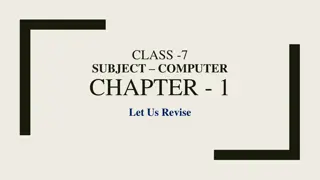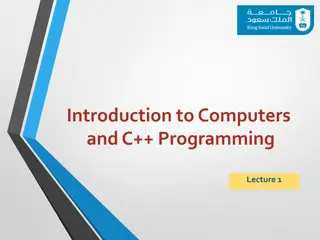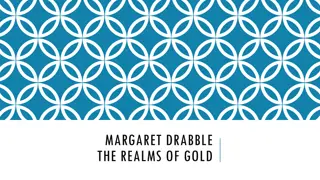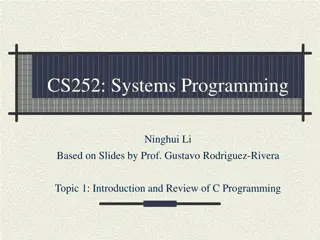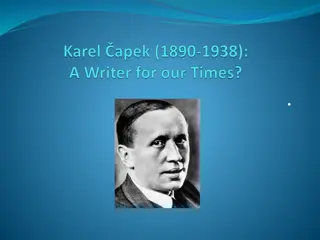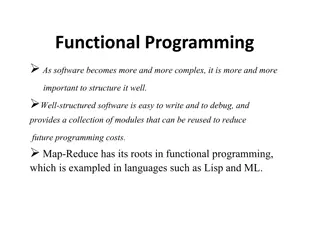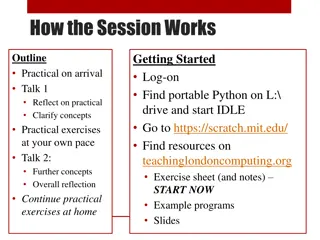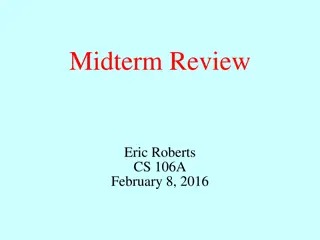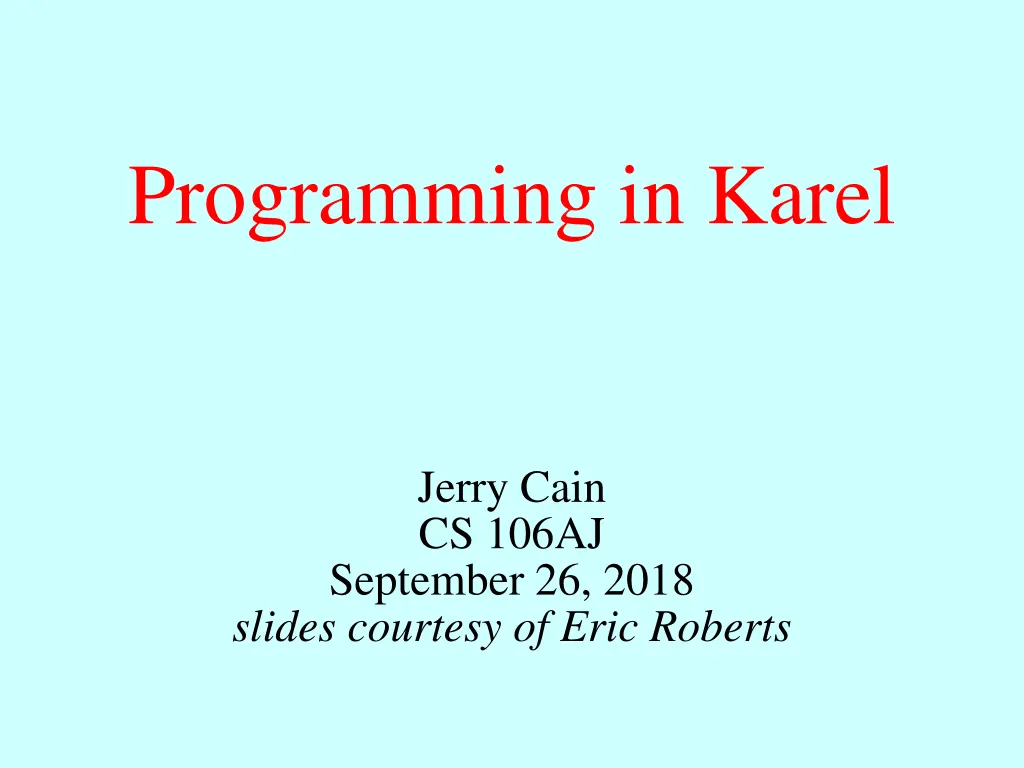
Introducing Karel the Robot: Programming Language Overview
Learn about Karel the Robot, a programming language developed by Rich Pattis. Discover the history, commands, and syntactic rules in this gentle introduction to the art of programming. Dive into defining new functions and understanding the common patterns in Karel programs. Get ready to explore the world of Karel and embark on your coding journey!
Download Presentation

Please find below an Image/Link to download the presentation.
The content on the website is provided AS IS for your information and personal use only. It may not be sold, licensed, or shared on other websites without obtaining consent from the author. If you encounter any issues during the download, it is possible that the publisher has removed the file from their server.
You are allowed to download the files provided on this website for personal or commercial use, subject to the condition that they are used lawfully. All files are the property of their respective owners.
The content on the website is provided AS IS for your information and personal use only. It may not be sold, licensed, or shared on other websites without obtaining consent from the author.
E N D
Presentation Transcript
Programming in Karel Jerry Cain CS 106AJ September 26, 2018 slides courtesy of Eric Roberts
Rich Pattis and Karel the Robot Karel the Robot was developed by Rich Pattis in the 1970s when he was a graduate student at Stanford. In 1981, Pattis published Karel the Robot: A Gentle Introduction to the Art of Programming, which became a best-selling introductory text. Pattis chose the name Karel in honor of the Czech playwright Karel Capek, who introduced the word robot in his 1921 play R.U.R. In 2006, Pattis received the annual award for Outstanding Contributions to Computer Science Education given by the ACM professional society. Rich Pattis
Review: Primitive Karel Commands On Monday, you learned that Karel understands the following commands: Move forward one square Turn 90 degrees to the left Pick up a beeper from the current square Put down a beeper on the current square move() turnLeft() pickBeeper() putBeeper() At the end of class, we designed a Karel program to solve the following problem: 3 3 + + + + + + + + + + + + + + + + + + + + 2 2 + + + + + + + + + + 1 1 1 1 2 2 3 3 4 4 5 5
The MoveBeeperToLedge Program /* * File: MoveBeeperToLedge.k * ------------------------- * This program moves a beeper to a ledge. */ function moveBeeperToLedge() { move(); pickBeeper(); move(); turnLeft(); move(); turnLeft(); turnLeft(); turnLeft(); move(); putBeeper(); move(); }
Syntactic Rules and Patterns The definition of moveBeeperToLedge on the preceding slide includes various symbols (such as curly braces, parentheses, and semicolons) and special keywords (such as function) whose meaning may not be immediately clear. These symbols and keywords are required by the syntactic rules of the Karel programming language, in much the same way that syntactic rules govern human languages. When you are learning a programming language, it is often wise to ignore the details of the language syntax and focus instead on learning a few general patterns. Karel programs, for example, fit a common pattern in that they define one or more functions that describe the steps Karel must perform in order to solve a particular problem.
Defining New Functions In Karel and in JavaScript as you will see beginning next week a function is a sequence of statements that has been collected together and given a name. All functions in Karel have the following form: function name() { statements that implement the desired operation } The first function in a Karel program is the main function, which is called when you press the Run button at the bottom of the screen. Most Karel programs define additional helper functions that implement individual steps in the complete solution.
The turnRight Function As a simple example, the following function definition allows Karel to turn right by executing three turnLeft operations: function turnRight(){ turnLeft(); turnLeft(); turnLeft(); } Once you have made this definition, you can use turnRight in your programs in exactly the same way you use turnLeft. In a sense, defining a new function is analogous to teaching Karel a new word. The name of the function becomes part of Karel s vocabulary and extends the set of operations the robot can perform.
Helper Functions in a Program function moveBeeperToLedge() { move(); pickBeeper(); move(); turnLeft(); move(); turnRight(); move(); putBeeper(); move(); } /* Turns Karel right 90 degrees */ function turnRight() { turnLeft(); turnLeft(); turnLeft(); }
Exercise: Defining functions Define a function turnAround that turns Karel around 180 . function turnAround(){ turnLeft(); turnLeft(); } The turnRight and turnAround functions are so important that they are included in a library called "turns". Define a function backup that moves Karel backward one square, leaving Karel facing in the same direction. function backup(){ turnAround(); move(); turnAround(); }
Control Statements In addition to allowing you to define new functions, Karel also includes statement forms that allow you to change the order in which statements are executed. Such statements are called control statements. The control statements available in Karel are: The repeat statement, which repeats a set of statements a predetermined number of times. The while statement, which repeats a set of statements as long as some condition holds. The if statement, which applies a conditional test to determine whether a set of statements should be executed at all. The if-else statement, which uses a conditional test to choose between two possible actions.
The repeat Statement In Karel, the repeat statement has the following form: repeat (count){ statements to be repeated } } repeat (count){ statements to be repeated As with the other control statements, the repeat statement consists of two parts: The header line, which specifies the number of repetitions The body, which is the set of statements to be repeated The keyword repeat and the various punctuation marks appear in boldface, which means that they are part of the repeat statement pattern. The things you can change appear in italics: the number of repetitions and the statements in the body.
Using the repeat Statement You can use repeat to redefine turnRight as follows: function turnRight(){ repeat (3){ turnLeft(); } } The following function creates a square of four beepers, leaving Karel in its original position: function makeBeeperSquare(){ repeat (4){ putBeeper(); move(); turnLeft(); } }
Conditions in Karel Karel can test the following conditions: positive condition negative condition frontIsClear() frontIsBlocked() leftIsClear() leftIsBlocked() rightIsClear() rightIsBlocked() beepersPresent() noBeepersPresent() beepersInBag() noBeepersInBag() facingNorth() notFacingNorth() facingEast() notFacingEast() facingSouth() notFacingSouth() facingWest() notFacingWest()
The while Statement The general form of the while statement looks like this: while (condition){ statements to be repeated } The simplest example of the while statement is the function moveToWall, which comes in handy in lots of programs: function moveToWall(){ while (frontIsClear()){ move(); } }
The if and if-else Statements The if statement in Karel comes in two forms: A simple if statement for situations in which you may or may not want to perform an action: if(condition){ statements to be executed if the condition is true } An if-else statement for situations in which you must choose between two different actions: if(condition){ statements to be executed if the condition is true } else { statements to be executed if the condition is false }
Exercise: Creating a Beeper Line Write a function putBeeperLine that adds one beeper to every intersection up to the next wall. Your function should operate correctly no matter how far Karel is from the wall or what direction Karel is facing. Consider, for example, the following function called test: function test() { putBeeperLine(); turnLeft(); putBeeperLine(); } 3 2 1 2 1 2 3 4 5
Climbing Mountains For the rest of today, we ll explore the use of functions and control statements in the context of teaching Karel to climb stair-step mountains that look something like this: 4 3 2 1 1 2 3 4 5 6 7 8 9 10 11 The initial version will work only in this world, but later examples will be able to climb mountains of any height.



